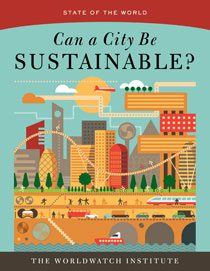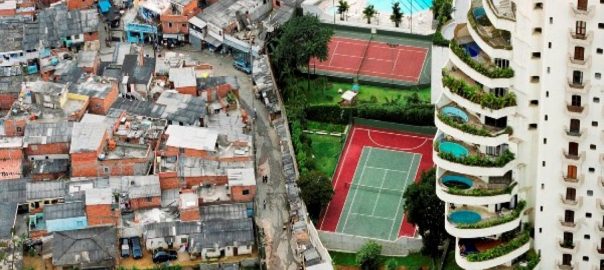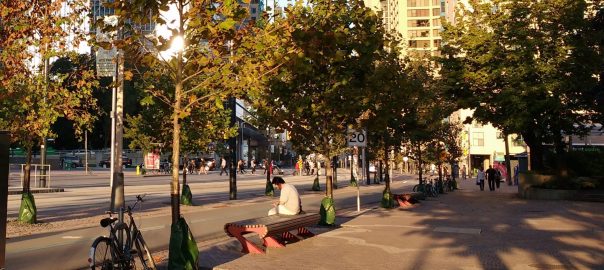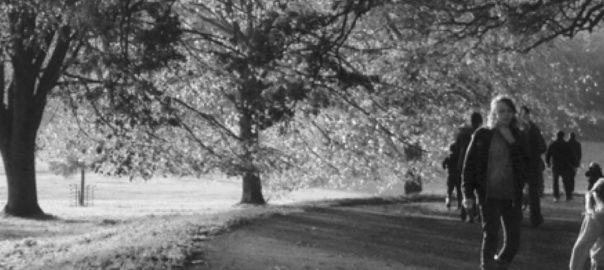A review of Can a City Be Sustainable? By Gary Gardner, Tom Prugh, and Michael Renner. 2016. Island Press. Buy the book.
This compact volume is an ambitious portmanteau of information on sustainable urbanism that covers an impressive range of issues and amply demonstrates how many of the essential initiatives needed to make sustainable cities are demonstrably achievable, with actions that can proceed immediately. Although the meaning of “sustainable” is assumed, rather than defined, by page 45 Gary Gardner, one of its key authors, answers the question posed in the book’s title with a one sentence encapsulation of the sustainable city vision:
A sustainable city is a vibrant human settlement that provides ample opportunities, in harmony with the natural environment, to create dignified lives for all citizens.
It’s hard to argue with that, although it doesn’t really pin down what “sustainable” means.
For the authors, a sustainable city “treats squirrels and robins, streams and trees, as neighbours rather than artifacts”.
 Chapter one in this book is “imagining a sustainable city”, but it curiously fails to mention that much of the early and current literature on the topic describes “ecological” cities. If I came to this book without much of a background in the topic, I could read it from cover to cover (and gain a lot of useful information) but remain unaware of the breadth and depth of the international ecocity movement and the various manifestations of ecocity ideas that have contributed to shaping and informing sustainable city initiatives for over three decades. Ecocities is a term that has been used to describe municipal programs that aim to make a city sustainable, to make claims of urban ascendancy based on sustainability, and as a label for visionary ideas about what the ultimate sustainable city might be like.
Chapter one in this book is “imagining a sustainable city”, but it curiously fails to mention that much of the early and current literature on the topic describes “ecological” cities. If I came to this book without much of a background in the topic, I could read it from cover to cover (and gain a lot of useful information) but remain unaware of the breadth and depth of the international ecocity movement and the various manifestations of ecocity ideas that have contributed to shaping and informing sustainable city initiatives for over three decades. Ecocities is a term that has been used to describe municipal programs that aim to make a city sustainable, to make claims of urban ascendancy based on sustainability, and as a label for visionary ideas about what the ultimate sustainable city might be like.
A brief exposition of the similarities or differences between eco and sustainable cities might have helped introduce newcomers to the range of literature that exists on this rapidly evolving and sometimes contentious topic. Likewise, “green cities” aren’t mentioned, although there is mention of a “Green City Index”. Yet every green city program or idea I’ve ever come across would readily, if not rather obviously, fit into any comprehensive discourse about sustainable cities.
The book covers many strategies for sustainable city making that aren’t always covered in the literature, such as remunicipalization (return to public ownership at a local level) of power utilities (notably in Germany). Gardner’s chapter on “Cities in the Arc of Human History: A Materials Perspective” is an excellent exposition of the inter-relationship between energy flows, materials and socio-economic change. Although not mentioned in the book, some of the pioneering work on energy use in cities (Newman and Kenworthy) comes from Australia. Australian researcher Stephen Boyden was responsible for the first published study (in 1981) of a city (Hong Kong) as an ecosystem. He has written compellingly on the biological history of civilisation and developed theory about the metabolic stages of civlisation. His “4 ecological phases of human existence” correlate strongly with the fourth socio-metabolic regime identified in the “Cities in the Arc of Human History” chapter and, although Boyden isn’t cited in this book, I’d recommend his work (here, here, and here) for those wanting to read more about the relationship between society, human development, cities and metabolism
The reality of making cities is prosaic and managerial. One part inspiration, nine parts perspiration. The book’s structure reflects this with the one part inspiration of the vision followed by the nine parts of perspiration chapters that describe the nuts and bolts of managing ideas on the ground. Given the variety of material covered in this compact volume the editors have done well to maintain the book’s overall character and focus.
This is not a book by or for designers (TNOC writer Tim Beatley’s concept of biophilic cities is described, for instance, but biophilia and biophilic design are not). It is pitched much more at municipalities, planners and people with a general interest in cities and sustainability. It is very much a book about existing cities and how they’re tackling, most of all, climate change. It’s a prosaic approach, but curiously inspiring. It will take you to the well of the vision but only provides an occasional sip—to slake your thirst you’ll need other tomes, sources that bubble out from the cracks in the homogeneity of modern culture. People like Soleri, Register, and Magnaghi (also here).
It is understandable that more recent and relatively untried concepts such as regenerative design aren’t dealt with in the text, but resilience is an increasingly influential concept that is strongly embraced by many advocates of urban sustainability. As a newly arrived denizen of the Melburnian metropolitan region, I was pleased to see Melbourne as one of the ten City View chapters, and mention of its participation in the 100 Resilient Cities Challenge, with “Australia’s first Chief Resilience Officer appointed to lead the development of a resilience strategy on behalf of the 31 local government areas that comprise metropolitan Melbourne”. The cautionary note here is that I didn’t know this until I read this book, which is a small measure of the communication gap that exists between the informed, considered actions of urban systems managers and the rest of the population! There are some problematic issues in relating resilience to sustainability (something explored in depth by Brenda Vale and Emilio Garcia in their new book Unravelling Sustainability and Resilience in the Built Environment) but it deserves wider consideration and, again, it would have been good to see some references and links to make it easier for readers to follow up and further explore key information.
Many times whilst reading this fascinating book, a fact would jump out at me. For example: “If food waste were a country, it would rank third in carbon emissions after the United States and China”.
In China, thanks to decades of advocacy by people like the late Professor Rusong Wang (National People’s Congress of China and Chinese Academy of Sciences), the idea of the ecocity became a meme for transforming the nation’s approach to development so that hundreds of municipalities were encouraged, by policy and fiscal incentive, to adopt ecocity characteristics in new development as a priority. It is not always easy to see the ‘eco’ in the explosion of urbanism that included these initiatives (Tianjin Ecocity is a notable exception) but the very idea has generated new strands of ideological DNA in the Chinese urban planning systems, which will likely have systemic impacts for decades to come. This is alluded to in the City View chapter on Shanghai, where the Dongtan Eco-city project gets a mention as a “notable failure”. One is left with a sense that urban environmental concerns get short shrift in China, but a more generous analysis suggests that, although China does often take a step backwards, it takes many more steps forward. Without gross inequities you can’t get to “sustainable” without passing through a certain level of development and the unprecedented urbanisation that has been taking place across China has delivered sewage treatment, reticulated water supply and electricity to millions of people who had no such amenities before. Anyone who has seen the state of villages and waterways in China prior to the recent urbanisation push is likely to share my opinion that there has been real environmental progress over the last decade or so. Interestingly, much of Peter Calthorpe’s chapter on “Urbanism and Global Sprawl” reads as an indictment of China’s explosive urban development and its inherent failings thanks to high-density urban sprawl.
Towards the end of the book, chapters on the “The Inclusive City” and “Urbanization, Inclusion and Social Justice” make the point strongly that social justice has to be integral to the concept of sustainable city. The challenge of achieving anything remotely like sustainability in modern cities is hugely dependent on having healthy, happy citizens and a reasonably equitable society, but as the conclusion of the chapter on “The Inclusive City” tells us: “Socioeconomic polarization and spatial segregation have become prevailing trends in cities worldwide”. In a world where the combined wealth of just eight individuals is equal to that of the 3.6 billion people who are the poorest half of the entire planet’s population, the chances of political will overcoming the problem of systemic inequality and exploitation (of both people and nature) appear slim. Whilst the general failure of national and state governments to address the core problems of climate change, ecological destruction and gross inequality suggests that city governments are now our last hope, the chapter on “Urbanization, Inclusion and Social Justice” cautions that “local governments rarely have self-sufficient power and knowledge to create or adequately manage city planning frameworks that safeguard citizens and assets for the long term”.
Curitiba, in Brazil, is one of those cities that has had that kind of self-sufficiency. It is, famously, the first city to have the hubris to call itself an ecocity, and is in many ways the poster child of the sustainable cities movement. Amongst other things it pioneered BRT (Bus Rapid Transit), kicked the car out of major inner-city streets, and introduced innovative garbage-for-credits tied to educational programs to reduce waste and help the urban poor—all achieved during the quarter century of mayoral leadership provided by Jaime Lerner. Given that the book acknowledges the importance of mayors worldwide in shaping and acting on the sustainability agenda, it is surprising that Lerner doesn’t rate a mention. Lerner recently produced a great little handbook on Urban Acupuncture (reviewed for TNOC) that has become a go-to reference for urbanists around the world. The inclusion of references and links to such material would have added to the usefulness of Can a City Be Sustainable?
In the chapter “Towards a Vision of Sustainable Cities”, Gardner identifies seven key principles that summarise “the broad spectrum of areas relevant to sustainability”:
- Reduced, Circulating, and Clean Flows of Materials
- A Prominent Place for Nature
- Compact and Connected Patterns of Development
- Creative Placemaking
- Centers of Well-being
- People-centred Development
- Participatory Governance
The essential ethos of an ecological city places cities firmly in the frame of needing to fit natural processes. That relationship with nature has to be central to achieving any kind of genuine sustainability, so I find Gardner’s principle 2—“A prominent Place for Nature”—falls short of what is needed. Cities are anthropocentric by necessity, but their long-term future is a chimera unless there is a powerful shift to a biocentric view of human settlement. This demands more than just “a prominent place”. Likewise, his “concise vision of urban sustainability” is a soft vision that seems calculated to avoid offending rather than inspire the conceptual and cultural shifts of the kind that are needed to get us beyond making cities merely less bad and begin addressing the real challenge of repairing the damage created by consumption, industrialisation, environmental mayhem and fossil-fuelled growth. When Gardner writes “In a sustainable city, nature is no longer an urban afterthought”, I couldn’t agree more, and in the chapter “The Vital Role of Biodiversity in Urban Sustainability” authors Juncà, Zaragoza and Guelar suggest that, used as one of the central measures of urban sustainability, biodiversity makes it possible “to promote and assess urban biodiversity, the ecosystem services that it provides, and broader ecological functions in cities”. But I think that many TNOC readers would appreciate seeing a much stronger call for nature to be central to any strategy for sustainable urbanism.
The book is full of useful and informative graphs, diagrams, tables and snippets of information—the chapter on “Supporting Sustainable Transportation” being noteworthy in this regard, and there are plenty of raw, hard-to-digest facts in this book. In the chapter on “Source reduction and Recycling of Waste”, for instance, we read that “Global waste flows show no sign of abating” whilst “waste-to-energy initiatives are predicated on an unabated continuation of waste flows”. 2.3 billion people—40% of the planet’s population—don’t have access to a toilet and there are nearly as many people without access to electricity and clean water as there were people on the entire planet when I was a child, so the prospect of achieving global sustainability seems as likely as keeping global warming to 1.5˚C. In that light, the proposition that the world’s cities can be made sustainable before the end of the century is even more preposterous, but what else can we do but try?
While I want to shout this stuff across the rooftops, the authors of this very well put together book might prefer a quiet and reasonable conversation. Both are necessary. Whether one chooses to shout about it or mention it in quiet asides to your local councillor, Can a City Be Sustainable? provides facts, figures and examples that help carry the argument for radical change in our urban environment.
In such a comprehensive and wide-ranging volume it is churlish to point out what is missing, so perhaps the best thing to say is that virtually every aspect of what it takes to get serious about sustainable cities is covered in this modest volume. With its numerous authors and viewpoints, this book is best read for its parts rather than as a whole, and would have benefited from a concluding chapter to bookend the content and tie the parts together. Overall, for all my own impatience (and tendency to nit-pick), and despite my reservations about the limited range of references and failure to make links to the rich history of knowledge and ideas in the ecocity movement, I have to say that Can a City Be Sustainable? is an excellent book that raises—and points toward the answers to—most of the many questions that are coiled up inside the disarmingly simple question posed in its title.
And, notwithstanding its northern hemisphere bias, my favourite sentence in Gardner’s chapter “Toward a Vision of Sustainable Cities” provides a lovely one-liner that I think I’ll be quoting for years. He writes that a sustainable city:
…treats squirrels and robins, streams and trees, as neighbours rather than artifacts.
Paul Downton
Melbourne
Click on the cover image to buy the book.








Leave a Reply